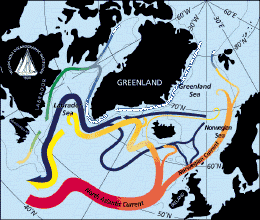2st PART
GULF-STREAM Gulf Stream is a surface ocean current, warm along the US coast from the Gulf of Mexico and that goes to the north-eastern Atlantic Ocean, pushed by the prevailing southwestern winds, getting gradually cooling . The Gulf Stream is one of the strongest currents. It moves warm water from the subtropical zones toward the poles. In autumn, the Gulf Stream moves to the north, while in the winter and spring it moves to the south (Auer 1987 ; Kelly and Gille 1990 ; Frankignoul et al. 2001). Compared to the width of the current (approximately 100-200 kilometers), the range of this variation (30-40 km) is relatively small (Hogg and Johns 1995). However, recent studies by Mariano and others (2002) suggest that the southern range of the annual change in the path of the Gulf Stream could be closer to 100 kilometers. According to Geosat altimetry results, the current carries a maximum amount of water in autumn and minimum in spring, in phase with the shifts north-south position (Kelly and Gille 1990; Zlotnicki 1991; Kelly 1991; Hogg and Johns 1995). Rago and Rossby (1985) and Fu et al. (1987) found similar results when they looked at the differences in the level of the sea. All these studies have found that the Gulf Stream has a marked seasonal variability, with the peak to peak amplitude of surface height sea of 10-15 centimeters. The fluctuation is mostly confined to 200-300 m above the water, it is a result of global warming and the seasonal expansion of surface waters (Hogg and Johns 1995). But changes in the transport of deep water seem to be almost opposite to the phase of surface waters, and their size is more significant (Hogg and Johns 1995).
Ocean currents like the Gulf Stream, distribute heat around the globe, as the atmosphere. According to calculations, ocean currents provide much of the heat released in the winter. But contrary to what many people think, the Gulf Stream has a small influence on the thermal contrast between the Europeans and Americans winters. On the other hand, ocean currents play a more important role in the north, by preventing the formation of sea ice along the Norwegian coasts. Based on numerical simulations oceanic transport of heat increases winter temperatures in Northeastern America and Western Europe up 35,6 to 37,4°F (2 to 3°C) either 10% of the warming generated by atmospheric motion.
EXCHANGES OF HEAT BETWEEN THE OCEAN AND THE ATMOSPHERE Like the atmosphere, the ocean plays an important rule on the climate. The water heats up more slowly than air, but it cools less rapidly unlike at the air. The ocean has a "memory" significantly longer than the atmosphere of the seasonal order concerning current of surfaces of the decade at least in regard to large masses of water in the deep ocean. La The heat stored like that in the water of the tropics is returned to the atmosphere at higher latitudes. Thus are generated ocean surface currents and depths that carry the heat from the equator to the poles. This helps to balance the excess of solar radiation received by the equatorial regions. Atlantic conveys probably more heat from the equator to the north thand the Pacific. It is estimated that the ocean contributes of about 30% to transport of the heat from equator to the poles, made by the climate system. Click
here to see an larger animation of the evolution During this transport, ocean and atmosphere continually exchange energy: on the surface of the ocean, these exchanges form superior flows to those streams proceeding from the Sun in the form of visible light. They are in the form of infrared radiation at wavelengths of the order of 10 to 12 µm. On the other hand, a very important exchange (in fact dominant) is made in the form of latent heat by the evaporation and condensation of the ocean water in the atmosphere. With the evaporation of water, this is higher in tropical, salinity increases but decreases with contribution of freshwater from rainfall and rivers. A second essential term in exchange of energy between the ocean and the atmosphere is due to the friction of the wind on the ocean surface. In summer, the sunniness is more important that warms the ocean surface. The winds shake the ocean water and redistribute this heat on a layer of a few about ten of meters of depth. Then this layer stores this energy. Then when winter comes, the sunniness is less important and the winds more violent. Ocean cools slowly releasing its heat into the atmosphere.
Click here to see currently the temperature of the surface of the oceans
Here's a video of the NASA explaining
the essential rule WARNING |






